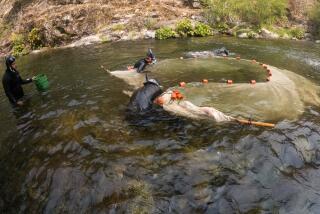Alaska Expects Record Fish Catch
- Share via
The projected catch of Alaskan halibut and salmon is expected to reach record levels this year, according to officials from that state’s seafood industry. The resulting bulging fishing boats will mean that a larger percentage of the harvest will make its way to Southern California in fresh form. The fishing season is currently under way and runs until September.
Industry analysts estimate that landings of halibut could exceed last year’s 66.4 million-pound total by as much as 10 million pounds.
The salmon projections are not as clear. But last year the state’s fishing fleet caught a record number of fish, or about 651 million pounds. The bulk of the salmon brought to shore is still canned. However, increasing amounts are being diverted to the fresh, frozen or cured market.
Alaskan seafood officials attribute the fleet’s success to the 200-mile fishing zone, which reserves much of the United State’s seafood resources for American fishermen. Also, the weather has played a major role in the effort by cooperating with ideal conditions.
The Chemistry of Food--Manufacturing those obscure chemical ingredients listed in the smallest of type on food labels is a booming industry. A recent study found that sales of the biochemicals used in foods will exceed $4.5 billion by 1989, up from the 1985 level of $3.9 billion.
The forecast, by the New York-based research firm of Frost & Sullivan Inc., found that the largest segment of the market is the high fructose corn sweeteners primarily used in soft drinks. This segment alone totaled $2.4 billion in sales last year. In fact, between 1980 and 1984, the amount of corn sweeteners used in soft drinks nearly doubled, from 4.4 billion pounds to 8.6 billion pounds.
The sharp increase parallels the switch many beverage companies made from cane and beet sugar to corn sweeteners in drink formulas. Coca-Cola Inc. was the first major firm to begin phasing out sugar in its beverage line in favor of the less costly corn-based substance.
Fresher Than Fresh--Whereas packaged foods continue to rely on increasing amounts of biochemical ingredients, the restaurant industry is being enticed to experiment with growing its own herbs and vegetables alongside the cutting board.
A Chicago-based firm has made it possible to grow the likes of parsley, basil and oregano right in the kitchen with the Green Acre Hydroponic system, which grows plants in a nutrient solution without soil. Those restaurateurs concerned about only the freshest ingredients can simply attach the self-contained hydroponic unit into the building’s water supply and then plug it into the nearest socket.
The recently available unit has the capability of growing 540 plants at one time, according to Restaurant & Institutions magazine. Granted, at that rate the herbs or vegetables being produced within the system would have to be on the small side because the unit is rather compact. It measures 6 feet high, 2 feet wide and 5 feet long. But the sight of only 100 hearty plants in today’s industrial restaurant kitchen is bound to lift the spirits of even the most curmudgeonly chef.
A bright sunny window in the kitchen is not a requirement because Green Acre is equipped with its own lighting and is capable of adjusting the amount of exposure the plants receive throughout the day, its manufacturer, Hydroponic Technologies, claims. Another benefit is that there is a minimal amount of maintenance needed to operate the unit, except for seeding the plants and then harvesting before use.
The magazine reported that an herb could be plucked from the system and be in the pesto sauce within five seconds.
A Southern Bouquet--As if California wine producers did not have enough problems with flat sales and foreign competition, now they must concern themselves with Arkansas, of all places.
Grape growers whose farms border the Arkansas River have petitioned the U.S. Bureau of Alcohol, Tobacco and Firearms to be designated a specific viticultural area called “Arkansas Mountain.” The agency defines such regions as having distinct geographic characteristics which set them apart from others. The designation is an important marketing tool that can help create a premium status for some wines.
There are currently eight wineries operating in the 4,500-square-mile area. However, a relatively insignificant 1,200 acres are currently planted with grapes. But growers are hoping the figure will significantly increase once the country gets a taste of Arkansas Mountain Riesling.
More to Read
Sign up for Essential California
The most important California stories and recommendations in your inbox every morning.
You may occasionally receive promotional content from the Los Angeles Times.










